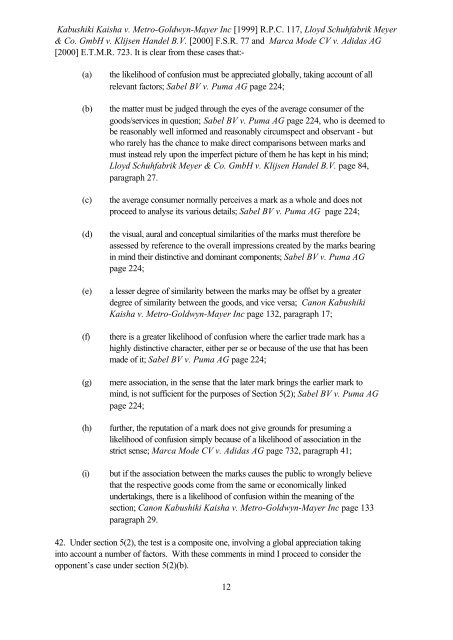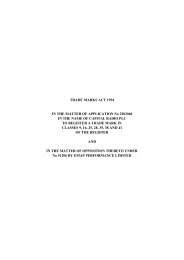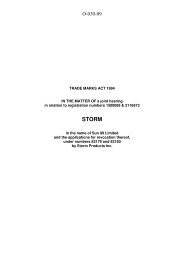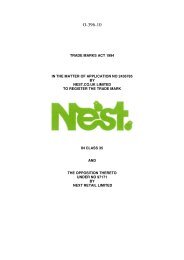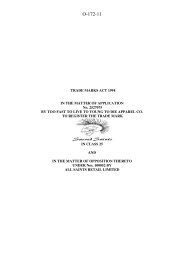Trade Mark Opposition Decision (O/509/02)
Trade Mark Opposition Decision (O/509/02)
Trade Mark Opposition Decision (O/509/02)
You also want an ePaper? Increase the reach of your titles
YUMPU automatically turns print PDFs into web optimized ePapers that Google loves.
Kabushiki Kaisha v. Metro-Goldwyn-Mayer Inc [1999] R.P.C. 117, Lloyd Schuhfabrik Meyer<br />
& Co. GmbH v. Klijsen Handel B.V. [2000] F.S.R. 77 and Marca Mode CV v. Adidas AG<br />
[2000] E.T.M.R. 723. It is clear from these cases that:-<br />
(a)<br />
(b)<br />
(c)<br />
(d)<br />
(e)<br />
(f)<br />
(g)<br />
(h)<br />
(i)<br />
the likelihood of confusion must be appreciated globally, taking account of all<br />
relevant factors; Sabel BV v. Puma AG page 224;<br />
the matter must be judged through the eyes of the average consumer of the<br />
goods/services in question; Sabel BV v. Puma AG page 224, who is deemed to<br />
be reasonably well informed and reasonably circumspect and observant - but<br />
who rarely has the chance to make direct comparisons between marks and<br />
must instead rely upon the imperfect picture of them he has kept in his mind;<br />
Lloyd Schuhfabrik Meyer & Co. GmbH v. Klijsen Handel B.V. page 84,<br />
paragraph 27.<br />
the average consumer normally perceives a mark as a whole and does not<br />
proceed to analyse its various details; Sabel BV v. Puma AG page 224;<br />
the visual, aural and conceptual similarities of the marks must therefore be<br />
assessed by reference to the overall impressions created by the marks bearing<br />
in mind their distinctive and dominant components; Sabel BV v. Puma AG<br />
page 224;<br />
a lesser degree of similarity between the marks may be offset by a greater<br />
degree of similarity between the goods, and vice versa; Canon Kabushiki<br />
Kaisha v. Metro-Goldwyn-Mayer Inc page 132, paragraph 17;<br />
there is a greater likelihood of confusion where the earlier trade mark has a<br />
highly distinctive character, either per se or because of the use that has been<br />
made of it; Sabel BV v. Puma AG page 224;<br />
mere association, in the sense that the later mark brings the earlier mark to<br />
mind, is not sufficient for the purposes of Section 5(2); Sabel BV v. Puma AG<br />
page 224;<br />
further, the reputation of a mark does not give grounds for presuming a<br />
likelihood of confusion simply because of a likelihood of association in the<br />
strict sense; Marca Mode CV v. Adidas AG page 732, paragraph 41;<br />
but if the association between the marks causes the public to wrongly believe<br />
that the respective goods come from the same or economically linked<br />
undertakings, there is a likelihood of confusion within the meaning of the<br />
section; Canon Kabushiki Kaisha v. Metro-Goldwyn-Mayer Inc page 133<br />
paragraph 29.<br />
42. Under section 5(2), the test is a composite one, involving a global appreciation taking<br />
into account a number of factors. With these comments in mind I proceed to consider the<br />
opponent’s case under section 5(2)(b).<br />
12


